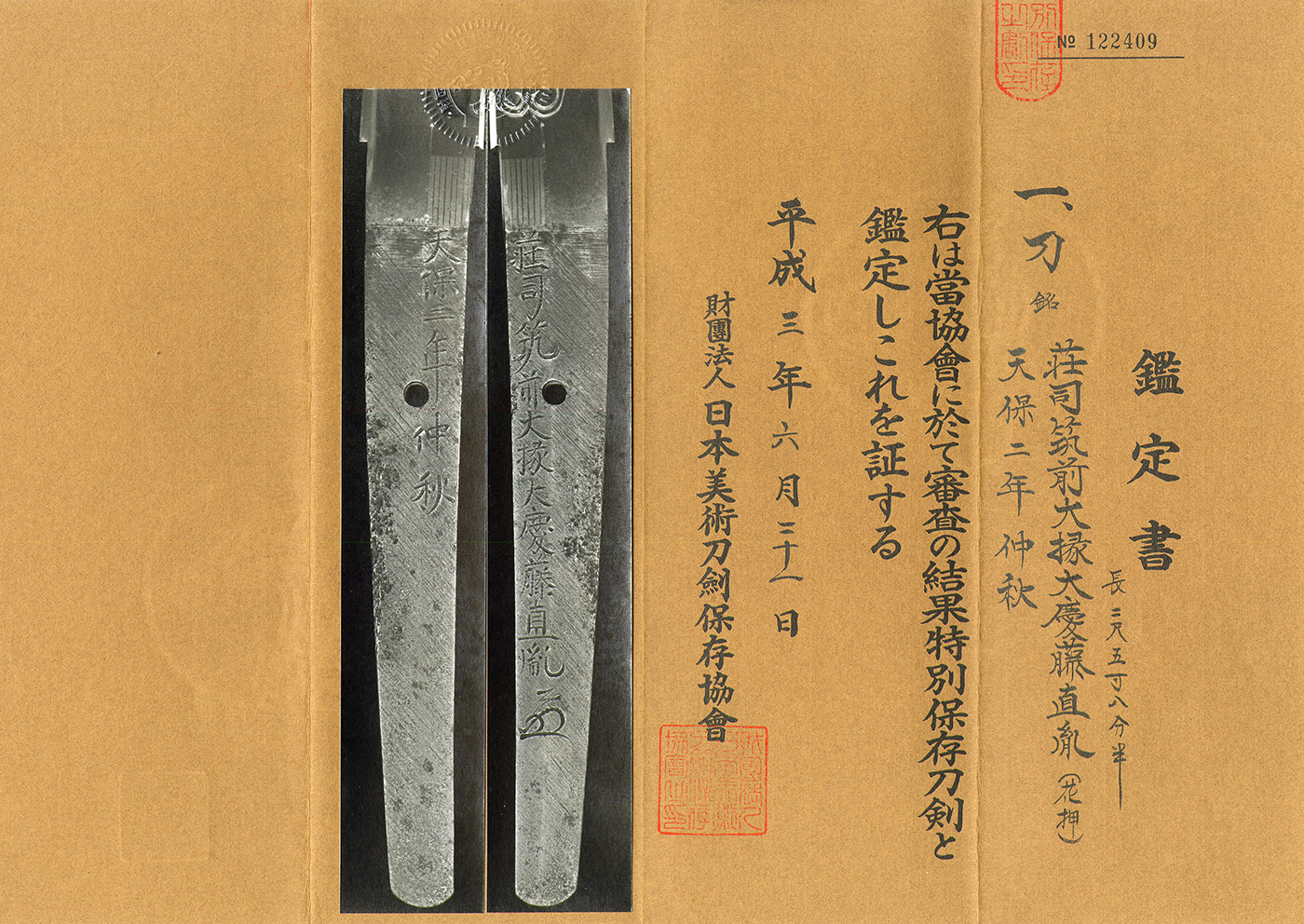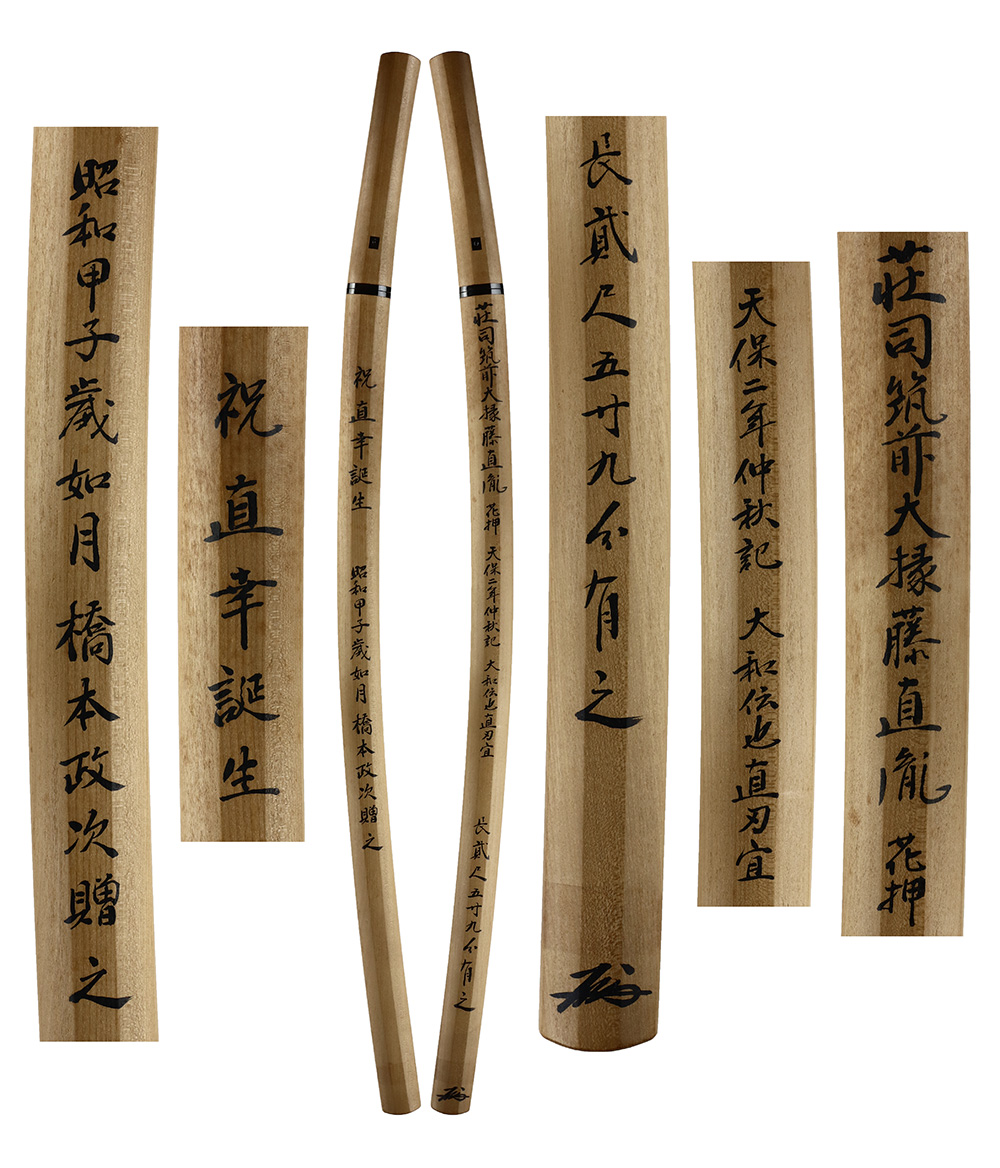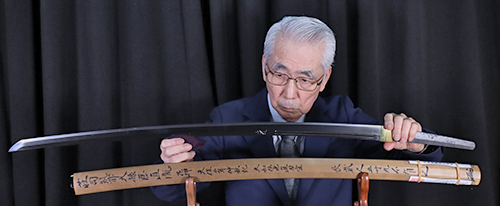Description
Katana in Shirasaya (NBTHK Tokubetsu Hozon Token)
Signature: Shoji Chikuzen Daijo Taikei Naotane (Kao)
Mid-Autumn of Tenpo 2 (1831)
荘司筑前大掾大慶直胤(花押)
天保二年仲秋
Shinshinto: Saijyo Saku: Musashi
We divide 4 sections for each sword as Saijyo Saku, Jyojyo Saku, Jyo Saku and Regular Saku.
This work is ranked as Saijyo Saku among the works of Taikei Naotane.
It has undergone the highest quality polishing.
Habaki: Single-layered gold foil
Blade Length: 78.4 cm (30.87 in)
Curvature: 2.2 cm (0.87 in)
Mekugi Hole: 1
Width at Base (Motohaba): 3.30 cm (1.30 in)
Width at Tip (Sakihaba): 2.14 cm (0.84 in)
Thickness of rim (Kasane): 0.84 cm (0.33 in)
Sword Weight: 955 g
Era: Edo period, Tenpo 2 (1831)
Shape: Broad and deeply curved, with an extended kissaki.
On the omote, it features double grooves with carvings of a nail and Sanskrit character; on the ura, double grooves and a Sanskrit character are carved.
Jigane: Straight grain pattern is clearly visible, giving an aged impression. This piece is reminiscent of Hoshō.
Hamon: Made with nioi, primarily suguha with a double hamon, incorporating sunagashi and kinsuji. The nioiguchi is deep and ends in a sweeping hakikake.
Features: Naotane was born in Uzen Yamagata and called himself Shoji Mino Hyobu, later taking the name Taikei.
He entered the school of Suishinshi and served the Akimoto lord along with his master.
Around 1821–1822, he received the title of Chikuzen Daijo and later became Mino no Kami in 1848.
He passed away on May 7, 1857.
In his youth, he also made works with active midare hamon.
In his middle years, he produced choji midare, saka-choji, and Soshu-den styles.
He also created works with straight grain patterns like this one and carved on the blade in the style of Yoshitane, producing a variety of artistic works.
Early works include notare and large gunome-midare similar to those of his teacher, Suishinshi Masahide.
However, since Masahide believed that active midare hamon could break easily and moved towards creating suguha-style small gunome midare, Naotane also began to avoid large gunome-midare patterns.
This work was made during the peak of his career in 1831, showing straight-grain jigane with chikei, double hamon with active kinsuji and sunagashi.
The boshi is midarekomi ending in hakikake.
It is a robust piece with clearly visible kinsuji.
Moreover, it has a sufficient length of 78.4 cm (30.87 in) and a deep curvature.
The blade is adorned with double grooves, Sanskrit characters, and a nail carving.
Aoi Art’s Comment: This piece, measuring 78.4 cm with deep curvature and self-carvings, was made when Taikei Naotane was 53 years old and in his prime.
Naotane rarely made straight grain pattern pieces, but this one features a prominent masame-hada with active hataraki such as prominent kinsuji, sunagashi, and a sweeping boshi.
The polishing is excellent, making the kinsuji, sunagashi, and double hamon inside the blade clearly visible.
NBTHK Tokubetsu Hozon Token
Aoi Art estimation paper
Whole Oshigata








 日本語
日本語





